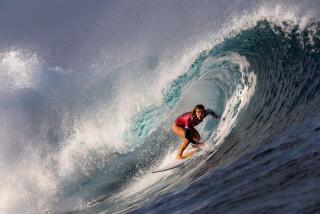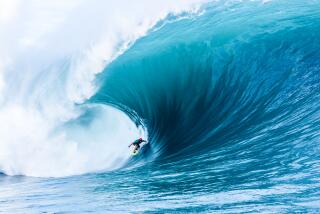Choosing a Suit With the Burrrrr Months in Mind
- Share via
Can you say “lighter and more flexible”? Thanks. We knew you could. That’s the catch phrase for state-of-the-art wet suits, originally created as bulky, thick rubber suits about as flexible as an iron lung.
Fig and I recently talked wet suits after Fig said, “It’s aggro to get a suit that’s ‘glued, blind-stitched and taped.’ ”
Yo, Fig. Is that a new rock band?
Fig: Negativo. We are just about ready for the burrs, and surfers need warmth as colder winter months approach.
Da burrs?
You know, Novemburrrr, Decemburrrr, when the water temperature drops and you get ice cream headaches paddling out.
Say, Fig, do you recall the coldest water you’ve ever been in?
It was at Ocean Beach in San Francisco. Water was in the low 50s, like 52 or 53 degrees, and the ocean was stormy with onshore winds. I had just gotten past the ARRRRGH! stage when the water rushes in and your body goes stiff. My head was banging from the cold, my hands were stinging, and I had only one thought in my mind.
A bonfire?
No. ‘Why am I really out here?’ But in 10 minutes I felt better, and I stayed in.
(He hee. Fig man uses humor to keep him warm sometimes.)
I can remember one frosty winter morning a long time ago in Oregon. It was sub-50-degree water. Even with full suit, booties, gloves and a hood, my feet were aching and my hands hurt. The long lulls between the sets killed me.
You should have had a blind-stitched wet suit or one with the new titanium liners.
Say what?
Fig says one wet suit company has blended titanium “micro flakes” into a jersey inner liner. The technology is light-years ahead of the early ‘50s, when Jack O’Neill in Santa Cruz developed some of the first wet suits for surfers.
Many people hate the restrictive feeling of wet suits, but Fig says warmth helps you stay loose.
You surf the way your wet suit feels, he says. If your wet suit is stiff, you’re gonna surf stiff.
In the San Francisco area, where it’s colder, you may have to wear a suit that’s 5 millimeters thick. In Orange County waters, it’s easy to get by with a 3mm-by-2mm suit--that’s a suit with 3 mils of thickness in the chest and back for warmth and a thinner 2-mil thickness in areas where you move the most, like the arms and shoulders.
Remember that the principle behind a wet suit is not to lock out the water. But you stay warm by having your body warm a thin sheet of water between you and the wet suit.
Let’s get heavy, Fig. Tell ‘em about the stitching stuff.
Well, the least costly, or basic seam, on economical wet suits is the overlock seam, which does the job. It’s not your warmest suit; it does leak water. Costs range from $125 to $150.
Next is the glued, blind-stitched and taped. Wet suit manufacturers glue the ends of neoprene together and then stitch the seam so the needle only penetrates halfway through the neoprene. They tape the stitching over so you don’t get chafed or get a wet suit rash. This allows for a smooth, comfortable and almost airtight bodysuit. Costs here range $175 to $225.
Fig says the wet suit using titanium flakes in the inner fabric retains the body heat and reflects excess heat.
It’s a hot-selling item right now and borrows its innovation from diving suits that run $500 to $800. It retails for $250.
O’Neill still puts out the most expensive wet suit, dubbed the Animal, which is a high-tech suit that retails for about $530.
Fig tip No. 1: While inspecting a wet suit, grab the elbow of a sleeve tightly with one hand. Then put your mouth inside the arm hole and blow a blast of air. An air bubble should form, then collapse. The better the suit, the slower it takes to collapse.
As for colors, it’s back to basic black. Fig says it’s like the old days, when surfers wanted to blend in with the whole scene.
Neon colors, which were popular in the 1980s, blasted the senses and scared away bull elephant seals.
We went as far as we could go with the day-glo orange, yellow, pink and stuff like that. People burned out on it. Now, it’s toned down again. Most suits are black, turquoise is really strong, and darker greens and purples.
People: Richie Collins of Newport Beach took first place and $6,000 in the U.S. Bud Tour Fall Classic at Seaside Reef by throwing a heavy vertical on an outer reef wave. Richie’s currently ranked 12th in the world Assn. of Surfing Professionals. Jeff Booth of Laguna Beach recently got second place at the Marui Japan Pro, and Martin Potter from Great Britain defeated Kelly Slater in the finals at Miyazaki Beach, Japan. Slater has a 1,000-point ASP lead heading into competitions in Brazil and Hawaii.
More to Read
Sign up for The Wild
We’ll help you find the best places to hike, bike and run, as well as the perfect silent spots for meditation and yoga.
You may occasionally receive promotional content from the Los Angeles Times.






